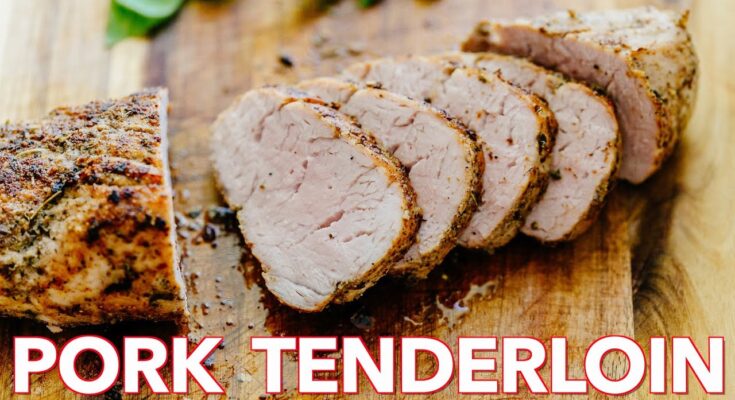Pork Tenderloin Recipe: Pork tenderloin is one of those versatile, lean cuts of meat that can easily become the star of your dinner table. Whether you’re a seasoned home chef or a kitchen newbie, pork tenderloin is relatively easy to cook, and with the right steps, it turns out tender and flavorful every time. Its mild flavor profile makes it a great canvas for a variety of seasonings and marinades, which is one of the reasons it’s a favorite across many households.
In this guide, we’ll walk you through a foolproof, step-by-step process to cook pork tenderloin perfectly. Plus, we’ll share tips on different cooking methods, flavor variations, and some of the common pitfalls to avoid.
What is Pork Tenderloin?
Pork tenderloin is a long, narrow, and lean cut of meat that comes from the muscle that runs alongside the backbone of the pig. It’s prized for its tenderness and mild flavor. Unlike pork loin, which is larger and often fattier, pork tenderloin is much smaller and cooks faster, making it an excellent choice for quick weeknight meals or special occasions.
Tenderloin can be cooked in various ways, such as roasting, grilling, or even pan-searing. Regardless of the method, the key is to avoid overcooking, as this lean cut can become dry if not properly handled.
Ingredients You’ll Need
Here’s a simple yet flavorful recipe to get you started:
- 1-2 pork tenderloins (1-1.5 lbs each)
- 2 tablespoons olive oil
- 2-3 garlic cloves, minced
- 1 teaspoon salt
- 1 teaspoon black pepper
- 1 tablespoon fresh rosemary, chopped
- 1 tablespoon fresh thyme, chopped
- 1 tablespoon Dijon mustard (optional)
- 1 teaspoon smoked paprika (optional for a smoky flavor)
Optional Add-ins:
- Lemon zest or juice for extra brightness
- Honey or brown sugar for a touch of sweetness
Feel free to tweak the seasonings based on your taste or what’s in your pantry!
Equipment Needed
- Sharp knife
- Cutting board
- Oven or grill
- Meat thermometer (essential!)
- Roasting pan or grill tongs
- Aluminum foil
How to Make Easy Pork Tenderloin
You’ll find the full, step-by-step recipe below — but here’s a brief overview of what you can expect when you make easy pork tenderloin:
Step 1: Clean and Trim the Pork
Begin by trimming off any excess fat or silver skin from the tenderloin. Silver skin is a thin layer of connective tissue that won’t break down during cooking, so it’s best to remove it. Use a sharp knife to carefully trim it away.
Step 2: Season the Tenderloin
Once trimmed, pat the tenderloin dry with paper towels. Rub it generously with olive oil and season with salt, pepper, garlic, rosemary, thyme, and any other seasonings you’re using. If you have time, let the pork marinate for at least 30 minutes, or up to overnight in the fridge for deeper flavor.
Step 3: Preheat Your Oven or Grill
Set your oven to 400°F (200°C) for roasting, or preheat your grill to medium-high heat. Proper preheating ensures even cooking and helps create that beautiful crust on the outside of the pork.
Cooking Methods for Pork Tenderloin
Method 1: Oven Roasting
- Place the seasoned pork tenderloin on a roasting pan.
- Roast for 20-25 minutes or until the internal temperature reaches 145°F (63°C).
- Remove from the oven and let it rest for 5-10 minutes before slicing.
Method 2: Grilling Pork Tenderloin
- Place the tenderloin on the grill and cook for about 15-20 minutes, turning occasionally.
- Use a meat thermometer to check the internal temperature, aiming for 145°F (63°C).
- Once done, let it rest before slicing.
Method 3: Searing and Finishing in the Oven
- Heat a skillet over medium-high heat and sear the tenderloin on all sides until browned.
- Transfer to the oven to finish cooking at 400°F (200°C) for about 10-15 minutes or until the internal temperature reaches 145°F.
How to Know When Pork Tenderloin is Done
The most reliable way to check doneness is by using a meat thermometer. Pork tenderloin should reach an internal temperature of 145°F. At this point, it will be perfectly juicy and slightly pink in the center, which is safe to eat according to the USDA.
Let the Pork Rest
Resting the pork after cooking is crucial. When meat rests, the juices redistribute throughout the meat, making it more tender. Let the tenderloin rest for about 5-10 minutes before slicing.
Slicing and Serving Your Pork Tenderloin
When slicing the pork, use a sharp knife and cut it into 1/2-inch thick medallions. Serve with sides like roasted vegetables, mashed potatoes, or a fresh salad. A drizzle of a pan sauce or gravy can elevate the meal even further.
Variations on Pork Tenderloin Recipes
- Honey Garlic Pork Tenderloin: Mix honey, garlic, soy sauce, and a splash of vinegar for a sweet and tangy glaze.
- Herb-Crusted Pork Tenderloin: Coat the pork with a mixture of breadcrumbs, Parmesan cheese, and herbs for a crispy, flavorful crust.
- Spicy Cajun Pork Tenderloin: Rub the pork with Cajun seasoning for a spicy kick.
Tips for Storing and Reheating Leftovers
To store leftovers, place the pork in an airtight container in the refrigerator for up to 3 days. To reheat, gently warm it in the oven or microwave with a little bit of moisture (like broth or water) to prevent it from drying out.
Common Mistakes to Avoid
- Overcooking: Always use a thermometer to avoid overcooking, which can result in dry pork.
- Skipping the Resting Period: Skipping rest time can cause the juices to spill out, leading to drier meat.
- Not Enough Seasoning: Don’t be afraid to generously season the pork for maximum flavor.
FAQs about Pork Tenderloin Recipe
What is the best way to cook pork tenderloin?
The best way to cook pork tenderloin is by roasting it in the oven at 400°F for 20-25 minutes or until the internal temperature reaches 145°F. This ensures a juicy, tender result.
Should pork tenderloin be cooked fast or slow?
Pork tenderloin is a lean cut, so it’s best cooked quickly at a high temperature to prevent it from drying out. Slow-cooking can cause it to lose moisture.
Do you need to marinate pork tenderloin?
Marinating pork tenderloin enhances its flavor but isn’t necessary. If marinating, aim for at least 30 minutes, or up to 24 hours for deeper flavor.
How do you keep pork tenderloin from drying out?
To prevent drying, avoid overcooking and let the tenderloin rest for 5-10 minutes after cooking. This allows the juices to redistribute, keeping it moist.
What are some good seasoning options for pork tenderloin?
Pork tenderloin pairs well with simple seasonings like garlic, rosemary, thyme, and olive oil. For a bolder flavor, try spice rubs with paprika, cumin, or chili powder.
Conclusion
In summary, achieving the perfect pork tenderloin involves a few simple but key steps. Start by selecting a high-quality cut of meat, season it generously, and cook it to the ideal internal temperature for juicy results. Whether you choose to roast, grill, or sear your pork tenderloin, ensure it rests before slicing to lock in the flavors.
Don’t be afraid to experiment with different flavor profiles and cooking methods. From a classic garlic and herb rub to bold marinades, there’s plenty of room to get creative. Trying new seasonings or cooking techniques can elevate your pork tenderloin to new levels of deliciousness!



